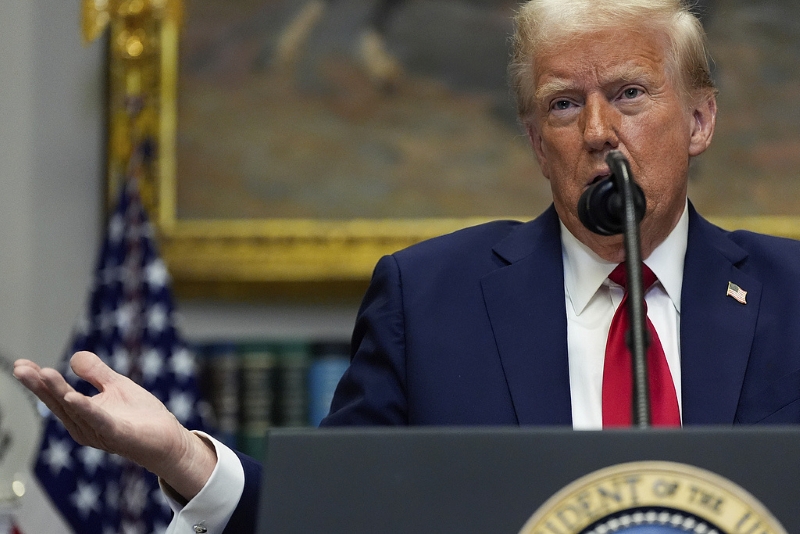The U.S. government’s long-anticipated “Artificial Intelligence (AI) Action Plan” has finally entered the public spotlight. According to a July 23 report by Time magazine, President Donald Trump is set to announce the long-awaited AI initiative on the same day. The plan includes mandatory directives for federal agencies and outlines several funding programs. Through this initiative, the U.S. hopes to ease regulatory constraints, invest heavily in infrastructure, and further cement its global leadership in AI.
However, just as the administration is pushing hard to advance AI, the highly anticipated “Stargate” project is reportedly facing serious setbacks. Meanwhile, with China rapidly rising as a major force in AI, American media have expressed growing concerns that the U.S. may lose its competitive edge.
The Action Plan Revolves Around Three Main Pillars
According to Time magazine, President Trump is scheduled to deliver a speech on Wednesday local time at the “Winning the AI Race” event in Washington, where he will officially unveil the “AI Action Plan.”
According to informed sources, the 20-page document is built around three core pillars: infrastructure, innovation, and global influence. It will be implemented primarily through directives to federal agencies and selective funding initiatives.
Sources say the plan is “more carrot than stick,” aiming to drive AI development through incentives rather than regulation.
The report shows that in terms of infrastructure, the plan emphasizes reforming permitting rules to streamline the construction process for new data centers, while also focusing on modernizing the power grid; in terms of innovation, it stresses that the United States must lead the world in innovation, with efforts focused on cutting red tape and reviving the idea of blocking state-level regulation of AI; in terms of global influence, the plan will highlight the importance of promoting American AI globally to prevent other countries from relying on Chinese AI models or chips.
According to an AP report on the 23rd, the core framework of the “AI Action Plan” stems from ideas repeatedly discussed by Silicon Valley tech leaders who support Trump’s campaign. As Bloomberg recently reported, Trump has shown strong interest in AI throughout his campaign, pledging to dismantle what he called “burdensome” regulations imposed by the previous administration to unlock AI’s full potential. Upon taking office, he swiftly repealed a 2023 executive order from the Biden administration and moved to establish a new policy framework—set to be announced Wednesday as the “AI Action Plan.”
Public records show that in January, Trump launched the $500 billion “Stargate” project to maintain America’s edge in global AI competition. Just last week, he announced $92 billion in energy and data center investments from companies including Google, AI cloud firm CoreWeave, and Blackstone, during an event in Pennsylvania.
“Stargate Project Still Taking Shape”
According to an exclusive report by The Wall Street Journal on the 22nd, the $500 billion “Stargate” initiative—jointly proposed by SoftBank and OpenAI—is struggling to take off. Six months after its launch, not a single project has broken ground. The report says the project’s goals have been scaled back, with plans now limited to building just one small data center by the end of the year.
The Stargate project, a multi-trillion-dollar joint effort backed by several companies, is focused on building large-scale data centers. Its goal is to turn the United States into a global “computing power empire.”
The Journal, citing insiders, reported that OpenAI and SoftBank—the project’s co-leads—have been divided over key issues such as site selection. Meanwhile, the roles and investment levels of two other partners—Oracle and the UAE-based MGX technology fund—remain unclear. Oracle CEO Safra Catz told investors in a recent call, “Stargate hasn’t taken shape yet.”
Seemingly in response to the Wall Street Journal‘s report, OpenAI released a statement on Tuesday announcing an agreement with Oracle to develop an additional 4.5 gigawatts of Stargate data center capacity. The announcement did not include a timeline or specific site details. However, OpenAI emphasized that thanks to the strength of its partners, Stargate is expected to exceed its original ambitions.
U.S. Media Worry About Losing the AI Race
On July 22, Bloomberg reported that PJM, the largest grid operator in the U.S., recently warned of a surge in electricity demand driven by AI technologies. This spike has maxed out grid capacity in areas with the highest density of data centers, leaving new projects with no available power. Joe Bowring, president of PJM’s independent monitor Monitoring Analytics, bluntly stated: “There is simply no new generation capacity to meet the load growth from data centers.”
Reuters also noted that AI’s vast data processing needs require a rapid expansion of power supply, which is straining utilities and grids across multiple U.S. states. Although existing transmission infrastructure is already overwhelmed, building new power generation facilities and connecting them to the grid remains a major hurdle, often requiring years of environmental and impact studies.
A recent article in Foreign Affairs expressed deep concerns over the future of U.S. leadership in AI. The article argues that technical innovation alone isn’t enough to win the competition with China. It notes that the U.S.’s relative advantage in computing power—partly due to export controls—is eroding, while China is rapidly catching up through homegrown innovation. Unlike the U.S., Chinese companies are focusing more on AI applications, which could give them the edge in creating disruptive products. The report warns that if China succeeds in deeply integrating AI into manufacturing—especially robotics—the U.S. could still lose the broader AI race.













Leave a comment